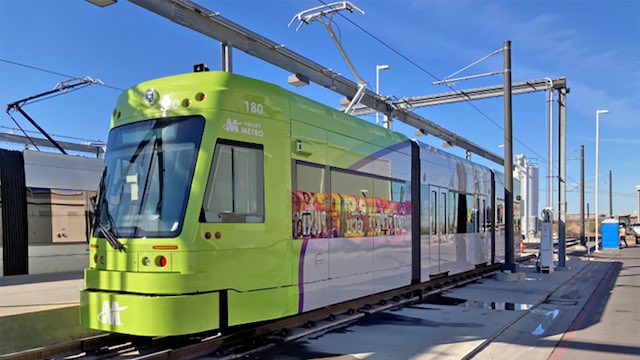Leave it to the transit industry to take a good idea and distort it beyond recognition or wisdom. That was my reaction when I learned that Tempe, Arizona began operating a hybrid streetcar last week. The three-mile streetcar line cost $200 million, or $67 million per mile.
For a mere $200 million, Tempe now has a streetcar that doesn’t work as well as a bus route that would have cost only about $3 million dollars. Photo courtesy of Valley Metro.
For rolling stock, Tempe elected to buy vehicles that cost $6.5 million apiece. At first glance, they look like other so-called modern streetcars, but have batteries that allow them to operate where there are no overhead wires. This makes them, according to their manufacturer, “the Prius of the modern streetcar market.”
The thing is, a Prius was designed to save energy. But the batteries required to operate the hybrid streetcars add almost 16,000 pounds to their weight, making them much less energy-efficient than other streetcars (which are already pretty energy-inefficient). For example, Portland’s streetcars used 64,000 BTUs per vehicle-revenue mile in 2020. By comparison, Oklahoma City’s hybrid streetcars used 120,000 BTUs per vehicle-revenue mile.
Hybrid or not, modern streetcars are about 66 feet long, more than 50 percent longer than a conventional transit bus. Yet the streetcars only have about 32 seats, while the typical bus has 40. Transit agencies leave out seats to provide more standing room, which means if the streetcars ever actually fill up, more passengers would be forced to stand. But they rarely do: Portland’s streetcars carried an average of 14.6 riders (that is, passenger-miles per vehicle-revenue mile) while Oklahoma City’s carried 4.8 (rising to 6.1 in 2020).
As a result, even the most heavily used streetcar lines are a giant waste of energy. Portland’s required almost 4,500 BTUs per passenger-mile in 2019; Oklahoma City’s used more than 31,000! (To be fair, this declined to “only” 19,500 in 2020.) For comparison, the average car used less than 2,800 BTUs per passenger-mile in 2019 while the average light truck used less than 3,300.
So, for $200 million, Tempe got itself a bloated energy hog that will require hundreds of millions of dollars more if people want to go further than three miles. When it comes to streetcars, hybrid doesn’t mean saving energy; it means wasting it.









This makes them, according to their manufacturer, “the Prius of the modern streetcar market.”
A Prius is a hybrid that runs on gasoline and uses a relatively small motor/generator and battery to increase efficiency (readers here already know that). This demonstrates in print how ignorant and/or dishonest the manufacturer and Tempe officials are.
Which is more crazy, selling ice to the Inuit or running a trolley in Oklahoma?
Which is more crazy, selling ice to the Inuit or running a trolley in Oklahoma?
The line is only three miles long and yet they can’t afford to put up wires for the total length? Maybe it would be better to run on batteries for the entire trip. There used to be some streetcar lines like that (even in Manhattan) but I’m sure there are none in North America now
are there numbers that factor in labor costs with the busses compared to these electric streetcars?
This makes them, according to their manufacturer, “the Prius of the modern streetcar market.”
No, it makes them the laptop of the streetcar market.
Well, my poet days are over and I’m back to being me
As I enjoy the peace and comfort of reality
If my boy ever asks me what it is that I have learned
I think that I will readily affirm
“Son, it’s faster horses, younger women, older whiskey, more money.”